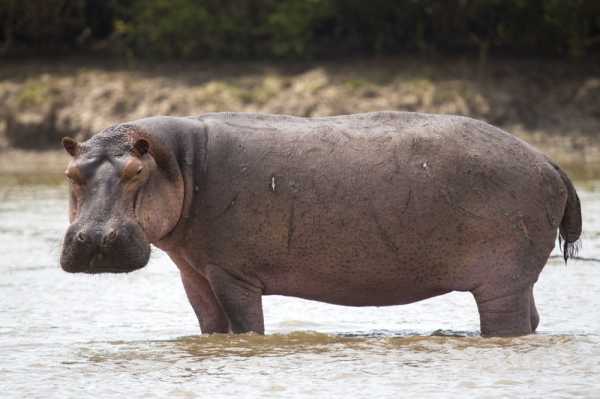
Hippos are being hunted for their teeth, and tusks (Photo: Wikimedia)
If asked to describe a hippopotamus, the chances are that you would conjure up an image of an enormous ungainly-looking mammal who spends its days languorously floating in African waters chomping on vegetation.
Appearances can, however, be deceptive. With their colossal bulk, powerful jaws and ability to move at surprisingly high speeds on land and in water, the common hippo can be dangerous to humans in case of conflict.
Yet, these formidable giants have more to fear from humans than the other way round. Indeed, the very survival of hippos is under threat. Not just as a result of the loss and degradation of their freshwater habitats, but from direct human exploitation and especially from the ever growing international trade.
The most recent International Union for Conservation of Nature (IUCN) assessment of the species in 2016 categorised it as “vulnerable”, which effectively means that hippos face a high risk of extinction in the wild. Their wild population has undergone a marked decline of over 30 percent over the past 30 years.
In fact, the IUCN found that hippo population trends were either decreasing or unknown in 25 of the 38 range states where these animals are found.
One of the reasons why hippos are particularly susceptible to over-exploitation is that they have a low rate of productivity with birth rates being further reduced — and population mortality also increased — by environmental conditions, such as drought.
Hippo populations in some countries have also suffered significantly from unregulated hunting, especially at times of civil unrest, as well as illegal trade in hippo teeth. Trophy hunting also places an additional pressure on populations with individuals being killed purely for fun.
Back in 1994, it was acknowledged that international commercial trade in hippo teeth had an impact on hippo populations.
This led to the common hippo being listed on Appendix II of the Convention on International Trade in Endangered Species of Wild Fauna and Flora (CITES) to closely control the trade in the species.
According to CITES trade data, between 2009 and 2018, a total of 77,579 hippo specimens, such as ivory carvings, teeth, raw tusks and leather items, plus 36,133kg of hippo ivory from teeth, derived from an estimated minimum of 13,909 hippos, were imported globally for commercial trade, or as hunting trophies or for personal purposes.
There are, however, discrepancies in the CITES data. Research has, for example, revealed that Hong Kong recorded that it had imported more than 14,000kg of hippo teeth from Uganda than were reportedly exported from Uganda between 1995 and 2013.
This strongly suggests that ivory from poached hippos is being laundered into legal trade.
It is, therefore, with good reason that 10 hippo range states, namely Benin, Burkina Faso, Central African Republic, Gabon, Guinea, Liberia, Mali, Niger, Senegal and Togo, have proposed the transfer of the common hippo to CITES Appendix I, which would prohibit legal international trade in hippos and their parts for primarily commercial purposes.
Hippos reproduce very slowly, at a rate of only one calf every two years, and this rate can slow considerably if environmental conditions, like drought or habitat loss, are present. Hippo scientists say that human culling of only one percent of the population, under these conditions, which are common across hippo habitats today, can lead to population declines.
Moreover, as rules for international and domestic trade in elephant ivory become ever more tightened, wildlife traders and traffickers are turning to ivory-bearing species like the hippo.
Factoring in other issues influencing the species’ decline, such as habitat loss and drought, it is evident that removing so many individuals from already dwindling populations will push these animals, known as ‘river horses’, closer towards extinction.
Transferring hippos to CITES Appendix I would effectively serve to prohibit all commercial international trade in hippo parts and products, which should throw a lifeline to this species in peril.
How EU can help
We believe that the hippo fully meets the trade and biological criteria for uplisting. The decision-making, however, lies very much in the hands of the parties to this convention.
Amongst them, the European Union and its 27 member states will play a decisive role in deciding the fate of the hippo.
The EU operates as a highly-influential bloc in the decision-making of multilateral environmental agreements, such as CITES.
They are often in the position to make or break the decisions, and have been known to waltz over the proposals of range states who are deeply concerned about the impact of trade on species that exist within their own borders.
As African nations, we are bearing direct witness to the decline of the hippo. This iconic species is already believed to be extinct in five other African countries, namely Algeria, Egypt, Eritrea, Libera and Mauritania. We do not want to see our own hippo populations go the same way due to an increase in international trade.
It is, therefore, deeply disappointing to learn last week that the EU intends to oppose our proposal at CITES.
Perhaps we should remind the EU Commission of its own Biodiversity Strategy to 2030, which recognises that more species are now being put at risk of extinction than at any point in human history and that, in the last four decades alone, global wildlife populations have fallen by 60 percent as a result of human activities, such as commercial trade.
The CITES preamble states that “peoples and states are and should be the best protectors of their own wild fauna and flora.” With 10 hippo range states asking for help to protect hippos from international trade, isn’t this failure to support the hippo proposal the sign that the EU refuses to keep its own commitments?
Source: euobserver.com



